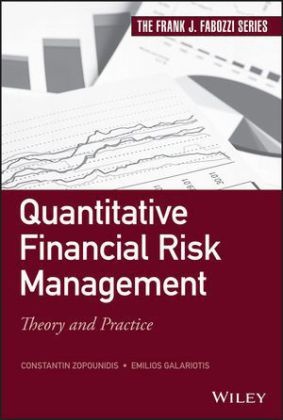En savoir plus
Informationen zum Autor CONSTANTIN ZOPOUNIDIS, PHD, is professor of Financial Engineering and Operations Research at Technical University of Crete in Greece and distinguished research professor at Audencia Nantes School of Management in France. EMILIOS GALARIOTIS, PHD (Dunelm), HDR, is professor of Finance at Audencia Nantes School of Management in France. He is the founder and director of the Centre for Financial and Risk Management and head of research in the area of finance, risk, and accounting performance at Audencia. He is also joint-Head of the Accounting and Finance Department. Klappentext A Comprehensive Guide to Quantitative Financial Risk ManagementWritten by an international team of experts in the field, Quantitative Financial Risk Management: Theory and Practice provides an invaluable guide to the most recent and innovative research on the topics of financial risk management, portfolio management, credit risk modeling, and worldwide financial markets.This comprehensive text reviews the tools and concepts of financial management that draw on the practices of economics, accounting, statistics, econometrics, mathematics, stochastic processes, and computer science and technology. Using the information found in Quantitative Financial Risk Management can help professionals to better manage, monitor, and measure risk, especially in today's uncertain world of globalization, market volatility, and geo-political crisis.Quantitative Financial Risk Management delivers the information, tools, techniques, and most current research in the critical field of risk management. This text offers an essential guide for quantitative analysts, financial professionals, and academic scholars. Zusammenfassung A Comprehensive Guide to Quantitative Financial Risk ManagementWritten by an international team of experts in the field! Quantitative Financial Risk Management: Theory and Practice provides an invaluable guide to the most recent and innovative research on the topics of financial risk management! portfolio management! credit risk modeling! and worldwide financial markets.This comprehensive text reviews the tools and concepts of financial management that draw on the practices of economics! accounting! statistics! econometrics! mathematics! stochastic processes! and computer science and technology. Using the information found in Quantitative Financial Risk Management can help professionals to better manage! monitor! and measure risk! especially in today's uncertain world of globalization! market volatility! and geo-political crisis.Quantitative Financial Risk Management delivers the information! tools! techniques! and most current research in the critical field of risk management. This text offers an essential guide for quantitative analysts! financial professionals! and academic scholars. Inhaltsverzeichnis Preface xvii About the Editors xix Section One Supervisory Risk Management Chapter 1 Measuring Systemic Risk: Structural Approaches 3 Raimund M. Kovacevic and Georg Ch. Pflug Systemic Risk: Definitions 4 From Structural Models to Systemic Risk 6 Measuring Systemic Risk 10 Systemic Risk and Copula Models 15 Conclusions 20 References 20 Chapter 2 Supervisory Requirements and Expectations for Portfolio-Level Counterparty Credit Risk Measurement and Management 22 Michael Jacobs Jr., PhD, CFA Introduction 22 Review of the Literature 25 Supervisory Requirements for CCR 26 Conceptual Issues in CCR: Risk versus Uncertainty 41 Conclusions 44 References 44 Chapter 3 Nonperforming Loans in the Bank Production Technology 46 Hirofumi Fukuyama and William L. Weber Introduction 46 Selective Literature Review 47 Method 51 Empirical Application 57 Summary and...

